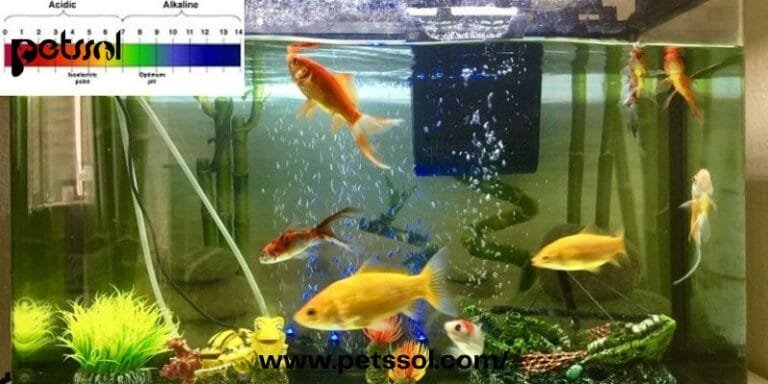How Do I Lower pH in Fish Tank? Maintaining the right pH level in a fish tank is crucial for keeping fish healthy and stress-free. pH levels directly impact their comfort and overall well-being. If the pH in our fish tank becomes too high, it can create an unhealthy environment that puts our fish at risk. In this guide, we’ll go over how to safely and effectively lower the pH in a fish tank and keep it stable over time.
Table of Contents
ToggleUnderstand pH Levels in a Fish Tank
The term pH refers to how acidic or alkaline the water is. It is measured on a scale from 0 to 14, with a pH of 7 being neutral. Water with a pH below 7 is acidic, while a pH above 7 means it is alkaline. Different species of fish prefer different pH levels, but for most freshwater fish, a pH between 6.5 and 7.5 is ideal.
pH levels in a fish tank can affect several important processes, including fish metabolism, nutrient absorption, and the efficiency of beneficial bacteria in the tank. Keeping the pH stable is just as important as keeping it at the right level because sudden changes can cause a lot of stress for fish. If pH becomes too high, it can lead to health problems, including issues with the gills, skin, and general stress.
Why Does pH Increase in Fish Tanks?
There are several reasons why the pH in a fish tank might increase over time. One of the most common reasons is the quality of the water used to fill the tank. If we use tap water that naturally has a high pH, it will cause the pH in our fish tank to rise. Additionally, certain decorations, such as rocks or gravel made of limestone, can leach minerals into the water that raise the pH.
Inadequate filtration can also play a role in increasing pH levels. Poor filtration allows waste and debris to build up, which can affect the water chemistry. Even the type of substrate (the material covering the bottom of the tank) can impact pH. Some substrates contain calcium or other elements that gradually dissolve and make the water more alkaline.

How Do I Lower pH in Fish Tank?
When trying to lower the pH in our fish tank, it’s important to do so gradually. A sudden drop in pH can cause stress to our fish, which can make them more susceptible to illness. There are several effective methods we can use to lower the pH safely and naturally.
Adding Driftwood to the Tank
One of the simplest ways to lower pH is by adding driftwood to the fish tank. Driftwood releases tannins, which are natural substances that make the water more acidic and gradually reduce the pH. This method is particularly effective for freshwater tanks, and it also has the added benefit of providing a more natural-looking habitat for fish.
When using driftwood, make sure we buy pieces that are specifically intended for aquarium use. Boiling the driftwood before placing it in the tank is a good idea, as it helps remove any impurities and ensures that it sinks easily. Once added to the tank, the driftwood will slowly release tannins, which will help lower the pH over time. It’s worth noting that this may cause the water to turn slightly brown, but this discoloration is harmless and can be filtered out if needed.
Using Peat Moss
Peat moss is another excellent natural option for lowering the pH in a fish tank. Similar to driftwood, peat moss releases tannins and other organic acids that reduce the pH level. Peat moss can be added to the tank in a couple of different ways. One common method is to place it in a mesh bag and add it to the filter, allowing water to pass through and gradually be treated by the peat.
Another way to use peat moss is by pre-soaking it in a container of water and then adding the treated water to the tank. This approach is a bit more controlled and allows us to adjust the pH more precisely. However, it is important to monitor the pH regularly, as peat moss can cause the levels to drop faster than expected.
Adding Indian Almond Leaves
Indian almond leaves, also known as catappa leaves, are a popular natural method for reducing pH levels in fish tanks. These leaves release tannins that make the water slightly more acidic. The leaves are often used by fish breeders to create a more natural and comfortable environment for their fish, and they can also promote the overall health of the tank.
Adding a few Indian almond leaves to the tank and allowing them to decompose naturally will slowly reduce the pH. The leaves also have antifungal and antibacterial properties, which can be beneficial to the fish. As with driftwood, these leaves may cause some discoloration in the water, but this is not harmful.
Using Reverse Osmosis (RO) Water
Reverse osmosis (RO) water is another option for lowering the pH in a fish tank. RO water is essentially pure water, free from the minerals and impurities found in tap water. By using RO water to dilute the tank water, we can reduce the overall pH. This approach is particularly useful if the tap water we use has a naturally high pH that is difficult to manage.
To use RO water, we simply mix it with regular tap water until we reach the desired pH level. It is important to be careful with this method, as adding too much RO water at once can cause a sudden drop in pH, which can be stressful for the fish. Ideally, we should make these adjustments slowly and keep an eye on the pH level to avoid any drastic changes.
The Role of Carbon Dioxide (CO2)
Injecting carbon dioxide (CO2) into the fish tank can help lower pH levels, especially in tanks with live plants. When CO2 dissolves in water, it forms carbonic acid, which naturally lowers the pH. This method is particularly suitable for planted aquariums because plants use CO2 for photosynthesis, and adding it can benefit both the plants and the fish.
To use CO2 injection effectively, we need to invest in a proper CO2 system that includes a regulator to control how much CO2 is released into the tank. Too much CO2 can cause the pH to drop too quickly, which could harm our fish. Regularly monitoring both CO2 and pH levels is essential to make sure everything remains balanced.
Commercial pH-Lowering Solutions
There are many commercial pH-lowering products available on the market that can be used to quickly reduce the pH in a fish tank. These products are typically in liquid form and are added directly to the tank water. While they can be effective, it is important to use them with caution.
Commercial solutions can lead to rapid changes in pH, which can be very stressful for fish if not done carefully. Always follow the instructions on the product label and add small amounts at a time, allowing the pH to adjust gradually. Regularly testing the water is crucial when using chemical treatments to avoid sudden changes.

Tips for Maintaining a Stable pH
Lowering the pH in a fish tank is only part of the process; it is just as important to maintain stable pH levels once we have them where we want them. Here are a few tips to help keep the pH in check:
Regular water changes are one of the best ways to maintain stable pH levels. By replacing a portion of the tank water with fresh, conditioned water, we can keep the water chemistry balanced and prevent pH from rising too much.
It is also important to avoid overfeeding our fish. Uneaten food can break down and contribute to waste in the tank, which can affect the pH. Feeding our fish just enough to meet their needs helps keep the tank cleaner and the pH more stable.
Having a proper filtration system in place is another key factor in maintaining a healthy pH level. A good filter will help remove waste and impurities from the water, reducing the likelihood of pH fluctuations.
Lastly, we should test the pH level regularly. Using a simple pH test kit once a week allows us to catch any changes early and make adjustments before the pH drifts too far from the desired range. Keeping an eye on the pH is one of the most effective ways to ensure a healthy environment for our fish.
Common Mistakes to Avoid
When trying to lower the pH in a fish tank, there are a few common mistakes that we should be mindful of. One of the biggest mistakes is making changes too quickly. Lowering the pH too fast can shock our fish, causing stress or even leading to illness. It’s always best to make small adjustments and monitor the fish’s behavior for any signs of stress.
Another mistake is using household products like vinegar or lemon juice to lower pH. While these substances are acidic and will lower pH, they can cause the pH to fluctuate wildly, which is not good for fish. It’s always better to use methods that are specifically designed for aquariums and that allow us to make gradual, controlled changes.
Failing to monitor the pH regularly is also a common issue. Even after successfully lowering the pH, it’s important to keep testing the water to make sure it stays at the right level. Regular monitoring helps us catch any potential problems early, before they become serious issues for our fish.
Conclusion
Maintaining the right pH in a fish tank is essential for the health and happiness of our fish. There are several ways to safely lower pH, whether we prefer natural methods like adding driftwood, peat moss, or almond leaves, or more advanced solutions like using RO water or injecting CO2. The key is to make gradual changes and monitor the water conditions regularly to ensure a stable environment.
Remember that each fish species has its own specific pH requirements, so always keep in mind the needs of the fish in our tank. By following these guidelines and taking care to maintain stable pH levels, we can provide our fish with a comfortable and thriving habitat.
For more information and helpful tips on pet care and health, check out our other articles at Petssol!
FAQs
-
What is the best pH level for a freshwater fish tank?
Most freshwater fish tanks should have a pH level between 6.5 and 7.5, depending on the type of fish. It is important to provide a consistent pH that matches the natural habitat of the fish species we have.
-
Can I use vinegar to lower pH in a fish tank?
Although vinegar can lower pH, it is not ideal for fish tanks because it can cause rapid and unpredictable changes. Instead, consider using driftwood or peat moss, which lower pH gradually and are much safer for fish.
-
How often should I check the pH in my fish tank?
It is recommended to check the pH at least once a week. Regular monitoring helps us maintain a stable environment and catch any issues before they negatively affect our fish.
-
Can live plants help maintain pH levels?
Yes, live plants can contribute to stable pH levels by using carbon dioxide during photosynthesis, which helps reduce acidity in the water. Live plants also improve the overall quality of the tank environment.
-
What are the effects of high pH on fish?
High pH can cause stress, gill damage, and skin irritation in fish. Prolonged exposure to elevated pH levels can also weaken their immune system, making them more vulnerable to disease.







